The Ember tetra (Hyphessobrycon amandae) or Fire tetra is an active, schooling fish that makes the ideal addition to a peaceful community aquarium. These sparkling little fish are easy to care for and make excellent beginner fish.
So, how long do Ember tetras live? What fish are good Ember tetra tank mates? And what are the differences between male vs. female Ember tetras?
Read this guide to learn all you need to know about Ember tetras.
Ember Tetra – At A Glance
Scientific Name
Hyphessobrycon amandae
Common Name (species)
Ember tetra, Fire tetra
Family
Characin
Origin
Araguaia River basin in Brazil
Diet
Omnivore
Care Level
Beginner-friendly
Lifespan
2 to 4 years
Temperament
Peaceful
Tank Level
All areas
Minimum Tank Size
10 gallons
Temperature Range
73o to 84o F
Water Hardness
5 to 17 dGH
pH Range
Around 6.6
Water type
Freshwater
Breeding
Egg layer
Compatibility
Peaceful community species
OK, for Planted Tanks?
Yes
Origins and Natural Habitat
Ember tetras are freshwater fish that come from the Araguaia River basin in Central Brazil, where the fish inhabit slow-moving, densely vegetated backwaters.
The fish’s natural diet is made up of tiny insect larvae, crustaceans, worms, algae, and some plant matter.
What Do Ember Tetras Look Like?
Interestingly, the Ember tetra’s diet and water quality heavily influence the fish’s color.
The fish’s popularity is largely due to its vibrant orange-red coloration, and as you can see from our pictures, the Ember tetra is a beautiful swimming gem!
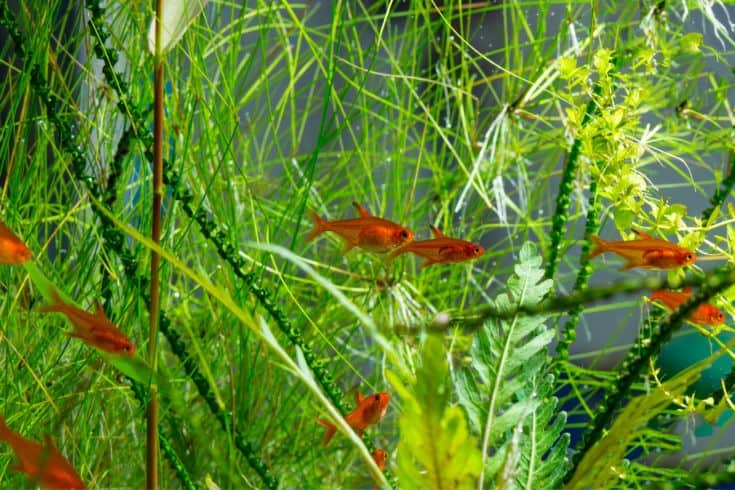
The fish has the characteristic tetra body shape, with a tall, slender dorsal fin that graduates from orange to a darker hue toward the rear of the fin before becoming completely transparent at the edges.
The caudal fin is forked and the same color as the fish’s body, being darker at the base, fading to virtually transparent. The ventral and pectoral fins are almost translucent, creating a flicking effect as the fish swims.
Ember Tetra Size
Ember tetras are tiny fish, growing to just under an inch in length when fully grown, making these fish perfect candidates for a small tank.
Ember Tetra Male vs. Female
It is possible to tell the difference between male and female Ember tetras, which is handy if you want to try breeding the fish in your home tank.
While male fish have bright colors, females are a little larger and rounder in shape than males, and their colors tend to be less vibrant.
How Long Do Ember Tetras Live?
The Ember tetra’s lifespan is relatively long when compared to other nano fish species, with the fish typically surviving for two to four years.
Keep your Ember tetras in a densely-planted fish tank and provide them with the proper care to maximize their life expectancy.
Behavior
They might be small, but the tiny Ember tetra makes up for its diminutive size by being one of the most active community fishes you can find! We recommend keeping a school of Fire tetras, as they make a spectacular sight, darting among your plants or swimming together in the center of the water column.
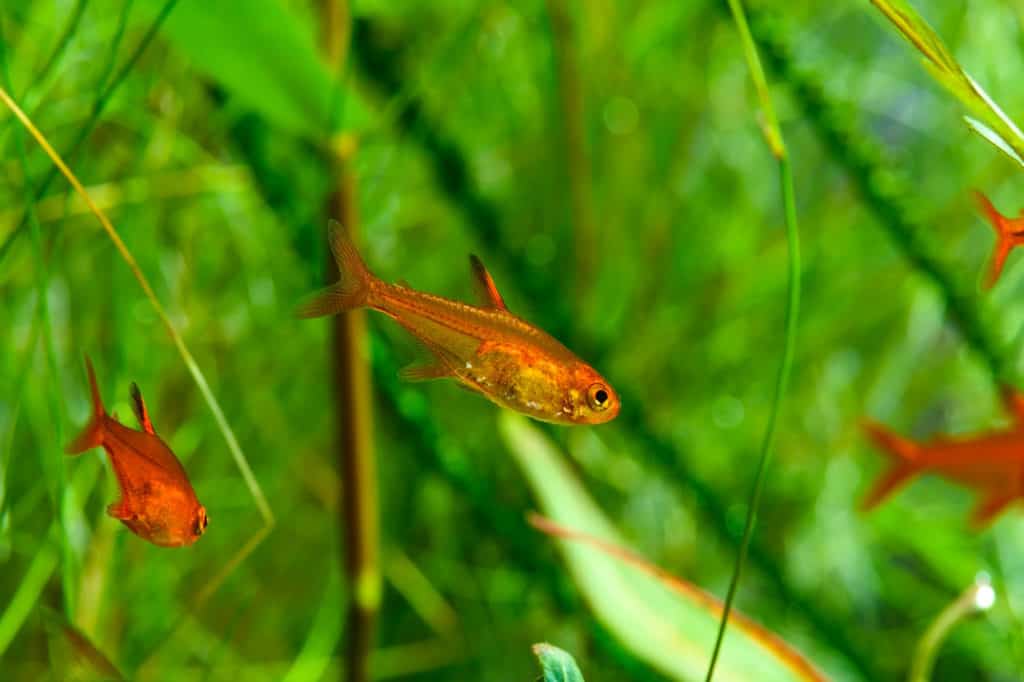
You can safely add groups of Ember tetras to a peaceful community tank, although you should avoid large, semi-aggressive fish species that might hassle or try to eat the tiny tetras!
Ember Tetra Tank Mates
Ember tetras must live in schools of at least eight to ten fish, although more than that is better if you have enough space to accommodate them.
If kept in smaller groups than that, the tetras will become timid and spend most of their time hiding away among your plants. In addition, large schools of these brilliantly colored fish make a much more effective display.
Good Tank Mates For Ember Tetras
Since Ember tetras are peaceful fish, they can live with most other small, non-aggressive species, including shrimp and snails.
To avoid stressing the tetras, we recommend combining them with bottom-dwelling fish, such as Corydoras catfish, and other shoalers, such as danios and rasboras. That can help to prevent competition for space in the Ember tetra’s preferred swimming area, and larger numbers of small fish make for a “safety in numbers” vibe for the fish.
Unsuitable Tank Mates
Fire tetras tend to lose their vibrant colors if stressed, so, as previously mentioned, you should steer clear of large, semi-aggressive fish that might try to make a meal of your tetras.
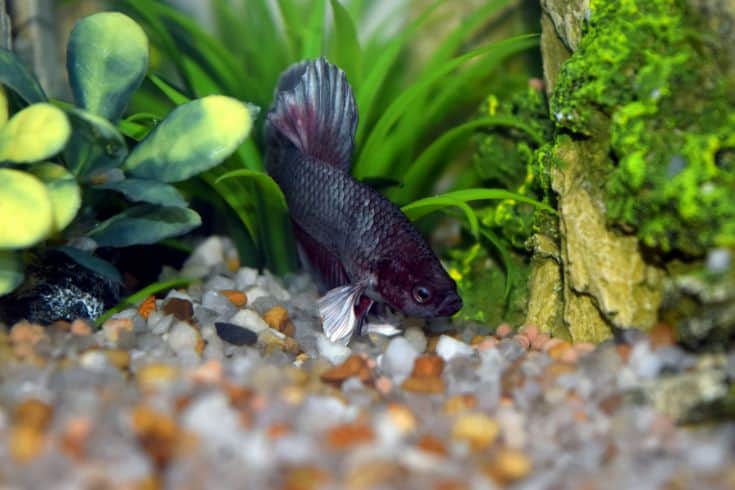
We also recommend avoiding keeping a betta fish with Ember tetras since some hobbyists have found the tetras to be nippy. That said, if you keep large numbers of Ember tetras, that behavior tends to disappear.
Diet and Nutrition
It’s essential to feed Ember tetras a high-quality, balanced diet to prevent their colors from fading.
We recommend giving your tetras a diet of high-quality tropical fish flakes and frozen meaty foods. Bloodworms, daphnia, and brine shrimp are all excellent sources of vitamins and protein that your Ember tetras will love!
It’s also worth using flake food that contains natural color-enhancing additives to really make your Ember tetras colors flame!
Live Foods
Although omnivorous aquarium fish species love a wide range of live foods, and most eat them in the wild environment, we recommend avoiding them.
Unfortunately, live food and the liquid it comes in often contain parasites that you don’t want in your aquarium. If you want to give your fish live food, the best option is to run a home brine shrimp hatchery.
How Much and How Often to Feed
Your tetras should be fed twice daily, once in the morning and again before the tank lights go out in the evening.
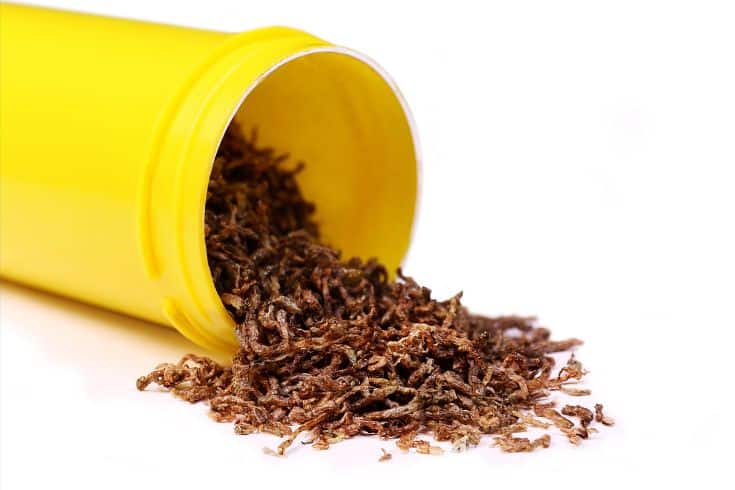
Give your fish what they will clear up in a few minutes to prevent overfeeding and avoid waste.
Tank Requirements
Tank size
Although these are tiny fish that could theoretically live in a 3 or 5-gallon tank, a 10-gallon aquarium is ideal for a small school of Ember tetras.
However, for a mega-school of 20 fish or more, you’ll need a larger tank, such as a 25-gallon setup.
Tank Setup
Substrate
To display your Ember tetras to the best effect, a dark substrate is the best choice, although that’s down to your personal preference. Gravel or sand both work well with these fish.
Decoration
When it comes to decorating an Ember tetra’s tank, the crucial thing to remember is that these fish love to live in a densely planted tank that closely mimics their natural habitat. Floating plants are a good option that creates dappled shade rather like the overhanging tree canopy in the fish’s natural environment.
You can also include twisted roots, smooth rocks, and driftwood to enhance the natural look of your tank, but do remember to leave plenty of swimming space where the Ember tetras can school.
Water Quality
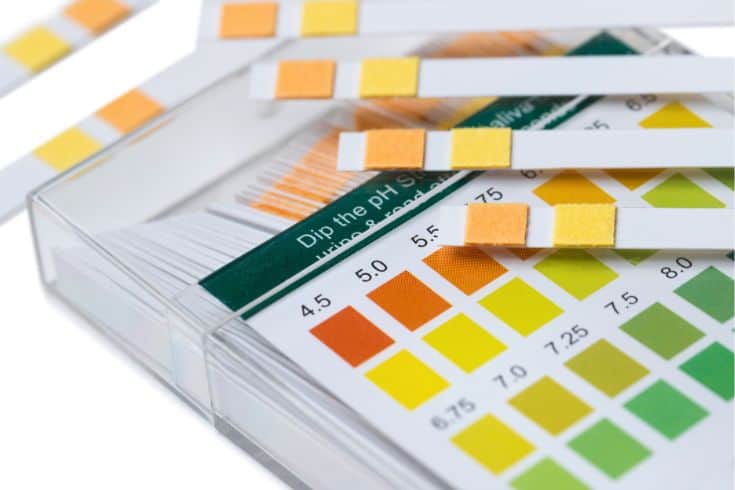
Ember tetras are not as fussy about water quality as some species. That said, your fish will thrive if given a clean, well-maintained environment.
Filtration
In the wild, Ember tetras live in slow-moving waters, so we recommend using a filtration system that creates a minimal water flow. A sponge or undergravel filter system that won’t buffet the fish or suck them into the filter inlet works well with this fragile species.
Water Parameters
Water Temperature
Ember tetras are tolerant of a range of water temperatures from 73°F to 84°F.
Water Hardness and pH Range
A pH of between 5.0 and 7.0 is fine for Ember tetras, and the optimal range of water hardness should be between 5 and 17 dGH.
Lighting
Ember tetras don’t have any special requirements when it comes to lighting.
That said, the fish live in a dimly-lit natural habitat, so as long as you provide shade by using floating plants and lots of bushy plants, regular aquarium lighting is fine for these fish.
Aquarium Maintenance
To keep the fish tank safe and clean for your tetras and other livestock, you must perform weekly partial water changes of around 25%.
Use an aquarium vacuum cleaner to get rid of uneaten fish food, organic waste matter, and decomposing plant matter that’s accumulated on the tank bottom. Although your fish will probably nibble on algae, use an algae magnet or scraper to remove most of the green stuff from your viewing panes.
Every month, you should rinse the filter media to get rid of any sludge that could clog the impeller, preventing water from circulating through the tank. Periodically, in line with the manufacturer’s recommendations, you’ll need to replace spent filter media.
How To Set Up Your Fish Tank
First, gather everything you need to set up your tank, including the following items:
- LED light unit
- Substrate
- Undergravel or sponge filter
- Heater
- Fish tank thermometer
- Decorations
- A variety of aquatic plants, including floating varieties
- Water dechlorinator
How To Set Up An Aquarium
- Rinse the substrate to get rid of dust.
- Put a few inches of the substrate into the aquarium.
- Fit the filter and heater to the tank, but don’t switch them on.
- Add dechlorinated tap water to the tank just under the fill line. I always put an upturned bowl in the tank and pour the water over that to avoid displacing the gravel.
- Add a drop or two of pure ammonia, some fish food, or a handful of gravel from a mature setup to the water to kick off the nitrogen cycle.
- Rinse your tank decorations in clean water, and arrange your ornaments in the aquarium.
- Prepare the plants by trimming off brown leaves and broken stems, and then add them to the tank. Place floating plants onto the water’s surface.
- Switch on your heater and filter. Your plants need eight to ten hours of light daily to photosynthesize, so set the timer on your aquarium lights, too.
- Wait for at least ten days for the nitrifying bacteria to become established in the biological filter media and on other aquarium surfaces. The bacteria process ammonia and nitrites into less harmful nitrates, keeping the water safe for your fish.
- Test the water daily until ammonia and nitrite levels are both zero and nitrates are close to 20 ppm. Once those levels are reached, you know that the tank is cycled and ready for your fish.
Health and Disease
Ember tetras are hardy fish, although they can be vulnerable to some common fish diseases.
Signs of Health in Ember Tetras
Healthy Fire tetras are active, schooling with their mates or exploring the plants and decorations.
Signs of Ill Health
The following behaviors could mean health problems in Ember tetras:
- Poor appetite
- Lethargy
- Hanging at the water’s surface
- Flashing or flicking against solid objects, plants, and the substrate
- Ulcers, sores, torn or bloody fins
Common Ember Tetra Health Issues and Treatment
Health Issue
Ich (White Spot Disease)
Symptoms or Causes
Ich is a very common disease that’s caused by an aquatic protozoan parasite.
Fish infected with Ich develop a sprinkling of tiny white spots on their fins, gill covers, and bodies. They also flash against the gravel and other solid objects in the aquarium.
Suggested Action
Raise the water temperature to 82o F for three days. Use an OTC White Spot Disease medication to treat the tank.
Health Issue
Flukes
Symptoms or Causes
Flukes is the term used to describe various types of external fish parasites. These macroparasites can often be seen with the naked eye attached to the fish’s skin or gills.
Suggested Action
Treat the fish tank with an OTC antiparasitic medication.
Health Issue
Fungal infections
Symptoms or Causes
White fluffy growths on the fish’s body, mouth, and head.
Suggested Action
Quarantine infected fish, and treat with an antifungal medication.
Health Issue
Bacterial infections
Symptoms or Causes
Sores and ulcers on the body and head, ragged, bloody fins.
Suggested Action
Treat the tank with OTC antibacterial treatment.
Breeding
If you provide your Ember tetras with a clean tank and a suitable environment, they can breed quite readily in the home tank.
Spawning Tank
If you have other residents in a community tank with your Ember tetras, setting up a dedicated breeding tank is the best way to go.
The ideal water temperature should be on the high side of the tetra’s preferred range at around 80°F or above, and the pH in the tank should be around 7.0. Those conditions mimic spawning conditions in the tetra’s home environment and usually trigger spawning.
Once the female has deposited her eggs and the male has fertilized them, the adult fish ignore the fry, and there’s no parental care shown toward the babies.
To avoid the fry being eaten, we recommend putting the parents back in your main tank or moving the babies to a separate tank.
The fry can be fed commercially prepared fry food, baby brine shrimp, and infusoria until they are large enough to eat finely crushed fish flakes.
Availability
Ember tetras are readily available from most fish stores, and you can also buy them online for a few dollars per fish.
Bearing in mind that you ideally want to keep a large group of these fish, it often works out cheaper to buy them in numbers.
Items You Need
- Algae magnet
- Fishnet
- Fish tank thermometer
- Aquarium siphon vacuum cleaner
- Sponge or undergravel filter unit
- Fish tank (10 or 25 gallons, depending on how many Ember tetras and tank mates you want to keep)
- Heater
- LED light unit
- Selection of live plants
- Tank decorations
- Fish food
- Dark-colored substrate
- Water dechlorinator
It’s also worth buying a good book on keeping tropical fish, especially if you’re a beginner fish keeper.
Final Thoughts
Did you enjoy our guide to the bright and beautiful Ember tetra? If you did, please share the article!
Ember tetras are also sold as Fire tetras. These gorgeous nano fish should be kept in large groups for the best effect in your aquarium and make an enchanting addition to any peaceful community tank.
If you provide your tetras with the ideal habitat and optimum conditions, you can breed them easily in your aquarium.
How many Ember tetras do you have in your tank, and what tank mates work best with them? Tell us in the comments box below!